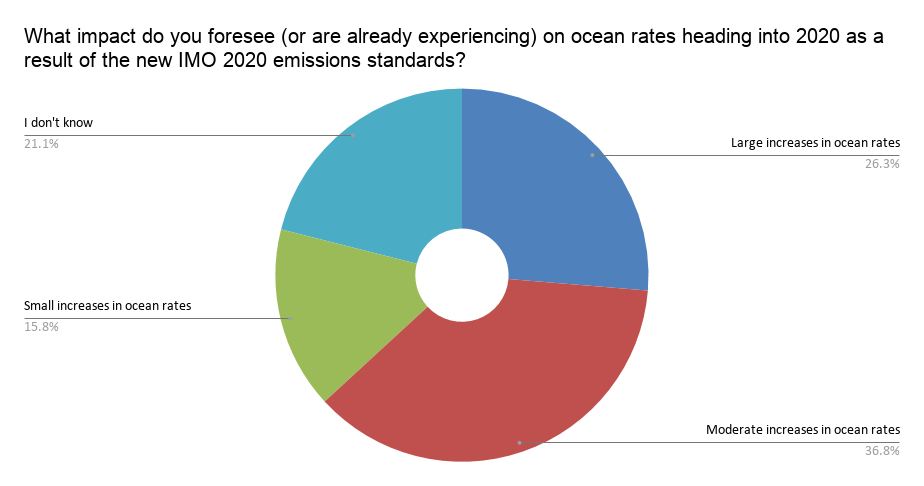Ever since my daughter started playing rugby last year, I’ve been following the sport a bit. The big news this week wasn’t about a match, but an interview with England’s Rugby World Cup star Joe Marler that some are calling the best sporting interview of all time.
If you’re a fan of Spinal Tap and Christopher Guest’s Nigel Tufnel character, as I am, you will definitely love this interview.
No “slightly Irish” horses in this week’s supply chain and logistics news, but there were plenty of items that caught my attention nonetheless:
- Ocean freight customers face significant fuel price rise next month (BIFA)
- ‘An arms race’: How retailers are trying to win on delivery ahead of the holidays (Modern Retail)
- Target CEO says cost of handling online orders drops 90% when shoppers use same-day options (CNBC)
- UPS to Use Sensors That Can Track Medical Packages at All Times (WSJ – sub. req’d)
- House Dems, Trump administration fail to reach deal on USMCA trade agreement (CNBC)
- Home Depot assesses tariff impact SKU-by-SKU (Supply Chain Dive)
- Trade restrictions among G20 economies remain at historic highs (WTO)
- Landstar, Prime among fleets telling owner-operators they’ll need to leave Calif. to continue as contractors (CCJ)
- Lineage Logistics Expands Global Cold-Storage Space with $900 Million Acquisition (WSJ – sub. req’d)
- Heating fuel shortage looms as strike at Canada’s biggest railroad hits third day (Reuters)
- UPS rolls out planned 2020 rate increases (Logistics Management)
- ATA Truck Tonnage Index Fell 0.3% in October
How Will IMO 2020 Impact Your Transportation Budget?
On January 1, 2020, the International Maritime Organization (IMO) will impose new emissions standards designed to reduce the acceptable levels of sulfur oxides (SOx) emissions in bunker fuel. As Mollie Bailey from Transplace (a Talking Logistics sponsor) wrote earlier this year in a guest commentary, “While these new emissions standards will reduce air pollution, they may have an initial negative impact across the container freight industry [on both rates and capacity].”
Earlier this month, we asked our Indago members “What impact do you foresee (or are already experiencing) on ocean rates heading into 2020 as a result of the new IMO 2020 emissions standards?” Of the member respondents that import or export via ocean, 63% expect moderate to large increases in ocean rates. Several members simply don’t know what to expect, as this executive commented: “The availability of information regarding surcharges [and] whether all steamships will convert to scrubbers has been difficult to obtain.”

Drewery, an independent maritime research consultancy, shed some light on what’s happening in the market right now. As reported by BIFA:
Shippers and freight forwarders are preparing to help carriers cover the extra cost of next year’s cleaner, low-sulphur fuel from next month, for which prices look set to be around 34-38% higher than the level paid for the current IFO 380 (intermediate fuel oil) fuel [emphasis mine]. And although transitional or ‘emergency’ bunker charges were only expected to apply to spot rates and contracts of less than three months, customers with annual contracts have also been requested by some carriers to start paying an IMO BAF from 1 December, container shipping analyst Drewry noted.
Have you factored the impact of the IMO 2020 regulation into your 2020 transportation budget? What actions have you taken (or plan to take) to mitigate its potential impacts on rates and capacity? Post a comment and share your perspective!
Retailers Competing on Delivery Speed
Over the past few years, there’s been some debate about what is more important for consumers, free or fast delivery. Well, when everyone is now offering free shipping, it’s not surprising that fast delivery is becoming a more important competitive weapon.
“Retailers trying to entice customers with free shipping options during the holiday isn’t entirely new,” writes Anna Hensel in ModernRetail. “But, retailers have been able to tout fast delivery as more of a differentiator this year as more of them have finally invested enough in fulfillment that they can offer same or next-day delivery, or buy online, pick up in-store. Walmart just introduced free next-day delivery in select markets earlier this year, while Target first only introduced same-day delivery after acquiring Shipt in 2017.”
Speaking of Target, as reported by CNBC this week:
When Target reported quarterly earnings on Wednesday, it said digital sales surged 31%, with its same-day services accounting for 80% of that growth [emphasis mine]. Those services include a curbside pickup option, same-day delivery via its Shipt network and buy online, pick up in store.
Target’s CEO Brian Cornell shed some light on fulfillment costs in the article:
[Cornell] said when Target fulfills an online order from the back of its stores versus shipping from a distribution center, “about 40% of the cost goes away.” He said when customers order online and pick up at a store, use curbside pickup or select shipping via Shipt, “about 90% of the cost goes away.”
“We certainly like that,” he said.
It would be interesting to see the breakdown of those cost reductions (labor vs. other factors), but it’s clear that click-and-collect and curbside pickup are the best options for retailers.
Do consumers want free or fast delivery? They want both, and they want options beyond home delivery. The challenge for retailers remains the same: determining how to compete on delivery profitably.
For related commentary on delivery, check out the following:
- Rent the Runway: The Consequences of Failed Delivery
- Domino’s Pizza And Panera: Keeping Control Of Delivery
- Amazon Prime Free 1-Day Delivery: Do We Really Need It?
- Above The Fold: How Will Same-Day Delivery Market Shake Out?
- Delivery: A New Moment Of Truth
And with that, have a happy weekend!
Song of the Week: “False Confidence” by Noah Kahan









